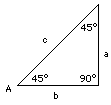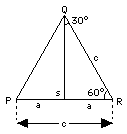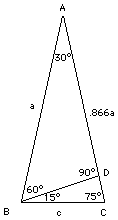|
Deriving the sine or cosine of an arbitrary angle takes a bit more math than is covered here. However, deriving them for a few special angles is relatively straightforward. Complementary anglesNote first of all that a right-angled triangle contains two angles. Since all three angles (in any triangle) add up to 180°, the two sharp angles add up to 90°. It follows that if one of the angles is of A degrees, the other one (its "complementary angle") is (90°- A). The sine and cosine were defined as the following ratios: sin A = (side opposite to A)/(long side) Because the side opposite to A is the one adjacent to (90°- A), it follows that the sine of one angle is the cosine of the other, and vice versa: sin A = a/c = cos (90° –
A) This is a great help: deriving (for instance) the sine and cosine of 30°also gives us, as a bonus, the sine and cosine of 60°. (1) A = 45° If A = 45°, then also (90° –
A) = 45°, and therefore
If A = 45°, then also (90° –
A) = 45°, and therefore
sin2 45° = 1/2
sin 45° = √2/√4 = √2/2
(2) A = 30°, (90° – A) = 60° Consider the triangle PQR (drawing) with all three angles equal to 60°. By symmetry, all three sides are equal too (a more rigorous proof exists, but we skip it). Drop a line QS perpendicular to PR: it divides the big angle into two right-angled triangles with sharp angles of (30°, 60°), which is the kind we are interested in. By symmetry, the triangles are of equal size and shape ("congruent") and therefore (skipping another proof)
Consider the triangle PQR (drawing) with all three angles equal to 60°. By symmetry, all three sides are equal too (a more rigorous proof exists, but we skip it). Drop a line QS perpendicular to PR: it divides the big angle into two right-angled triangles with sharp angles of (30°, 60°), which is the kind we are interested in. By symmetry, the triangles are of equal size and shape ("congruent") and therefore (skipping another proof)
In the notation of the drawing
a/c = 1/2 = sin 30° = cos 60°
Subtract 1/4 from both sides
cos 30° = √3/ √4 = (√3)/2 = 1.7320508/2 cos 30° = 0.8660254 = sin 60°
(3) A = 90° , (90° – A) = 0 It would be rather hard to draw a right-angled triangle with a second angle of 90° inside it, because the third angle then has to be 0°. But we can visualize this strange triangle as the limiting case of long skinny triangles with an angle A that is very steep and and its complement (90° –
A) very small (drawing). In the limiting case
It would be rather hard to draw a right-angled triangle with a second angle of 90° inside it, because the third angle then has to be 0°. But we can visualize this strange triangle as the limiting case of long skinny triangles with an angle A that is very steep and and its complement (90° –
A) very small (drawing). In the limiting case
cos A = b/c = 0 and since 1 = sin2A + cos2A = sin2A + 0 it follows that sin2A = 1 sin A = 1 Therefore cos 90° = sin 0° = 0 |

 Now look at the triangle BDC: its two larger angles equal 90° and 75°, forcing the remaining angle to be equal to 15°. Using the theorem of Pythagoras, if the long side is denoted c, we get
Now look at the triangle BDC: its two larger angles equal 90° and 75°, forcing the remaining angle to be equal to 15°. Using the theorem of Pythagoras, if the long side is denoted c, we get